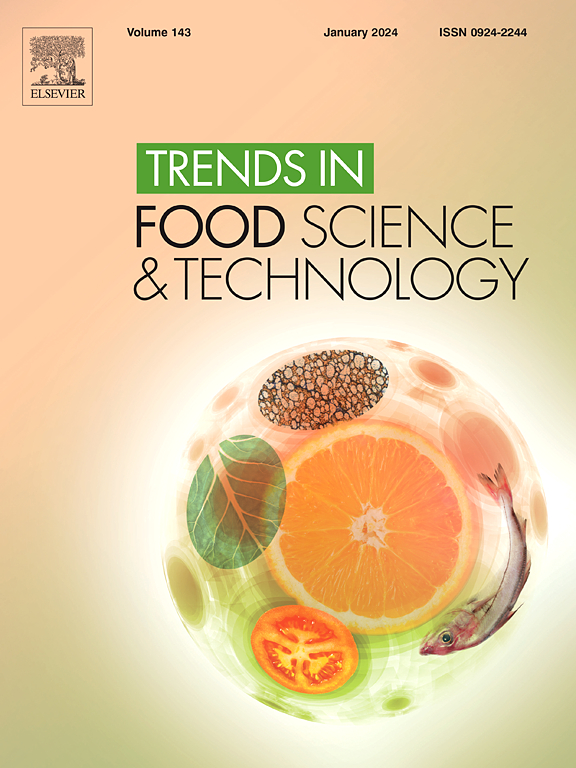用微生理系统推进食品纳米毒理学:重新平衡风险/收益比,以实现更安全的纳米食品创新
IF 15.1
1区 农林科学
Q1 FOOD SCIENCE & TECHNOLOGY
引用次数: 0
摘要
将纳米材料加入食品中提供了关键的好处,包括延长保质期,提高安全性,增强质量和质地。这些创新可以帮助解决现代粮食系统中的重大挑战,例如减少浪费和提高食品质量和安全。然而,潜在的毒性仍然是一个问题,缺乏评估摄入纳米材料的生理学相关模型。传统的体外和体内方法往往无法模拟胃肠道的复杂性,导致纳米毒性数据不一致和不可预测,从而阻碍了对纳米食品的准确风险评估。为了解决这一空白,本综述评估了微生理系统(MPS)的潜力,特别是肠道靶向MPS,用于模拟胃肠道纳米颗粒暴露。它研究了MPS技术如何复制与食物特异性风险评估相关的关键生理过程,包括肠道屏障功能、微生物群免疫相互作用和肠道器官交流。对技术进步及其在纳米毒理学中的应用进行了比较分析,探讨了MPS如何更好地用于纳米食品安全评价。smps技术通过复制关键的生理特征,如屏障功能、微生物-免疫相互作用和肠道-器官轴,为胃肠道建模提供了强大的工具。然而,其在食品纳米毒理学中的应用仍然有限,其全部潜力,特别是微生物组-免疫整合,尚未实现。关键挑战包括维持长期共培养,模拟消化和模拟纳米颗粒生物转化。此外,标准化、可重复性和监管一致性阻碍了更广泛的采用。本综述概述了解决这些障碍的策略,包括人工智能整合和多学科框架,以支持纳米食品安全中的MPS验证和监管吸收。本文章由计算机程序翻译,如有差异,请以英文原文为准。

Advancing food nanotoxicology with microphysiological systems: Rebalancing the risk/benefit ratio toward safer nano-enabled food innovations
Background
Incorporating nanomaterials into food products provides key benefits, including extended shelf life, improved safety, and enhanced quality and texture. These innovations could help tackle major challenges in modern food systems, such as reducing waste and enhancing food quality and safety. However, potential toxicity remains a concern, compounded by the lack of physiologically relevant models for assessing ingested nanomaterials. Traditional in vitro and in vivo approaches often fail to mimic gastrointestinal complexity, resulting in inconsistent and non-predictive nanotoxicity data that hinder accurate risk assessment of nano-enabled foods.
Scope and approach
To address this gap, this review evaluates the potential of microphysiological systems (MPS), particularly gut-targeted MPS, for modeling gastrointestinal nanoparticle exposure. It examines how MPS technologies replicate key physiological processes relevant to food-specific risk assessment, including intestinal barrier function, microbiota–immune interactions, and gut–organ communication. A comparative analysis of technological advances and their applications in nanotoxicology explores how MPS can be better adapted for nanofood safety evaluation.
Key findings
MPS technology offers a powerful tool for modeling the gastrointestinal tract by replicating key physiological features such as barrier function, microbiome-immune interactions, and gut–organ axes. However, its application in food nanotoxicology remains limited, and its full potential, particularly for microbiome–immune integration, has yet to be realized. Key challenges include sustaining long-term co-cultures, simulating digestion, and modeling nanoparticle biotransformation. Additionally, standardization, reproducibility, and regulatory alignment hinder broader adoption. This review outlines strategies to address these barriers, including AI integration and multidisciplinary frameworks to support MPS validation and regulatory uptake in nanofood safety.
求助全文
通过发布文献求助,成功后即可免费获取论文全文。
去求助
来源期刊

Trends in Food Science & Technology
工程技术-食品科技
CiteScore
32.50
自引率
2.60%
发文量
322
审稿时长
37 days
期刊介绍:
Trends in Food Science & Technology is a prestigious international journal that specializes in peer-reviewed articles covering the latest advancements in technology, food science, and human nutrition. It serves as a bridge between specialized primary journals and general trade magazines, providing readable and scientifically rigorous reviews and commentaries on current research developments and their potential applications in the food industry.
Unlike traditional journals, Trends in Food Science & Technology does not publish original research papers. Instead, it focuses on critical and comprehensive reviews to offer valuable insights for professionals in the field. By bringing together cutting-edge research and industry applications, this journal plays a vital role in disseminating knowledge and facilitating advancements in the food science and technology sector.
 求助内容:
求助内容: 应助结果提醒方式:
应助结果提醒方式:


